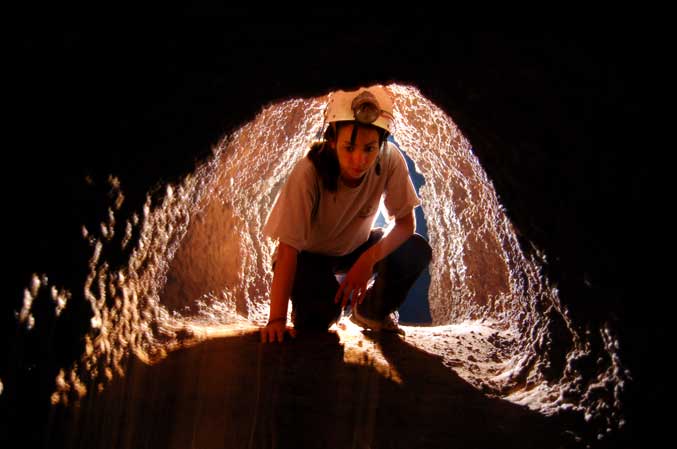ZURDO CAVE
By John Pint
In an article
entitled “Return to Paradise” I mentioned how we left the pleasures of a
steaming hot pool of water in the state of Nayarit and headed for Sanganguey
Volcano, located about 25 kms southeast of Tepic, to determine whether we could
find any lava tubes there. Three of us, Canadian Chris Lloyd, Mexican Luis Rojas
and I, drove into the little town of San José Mojarras in Nayarit and tried our
standard technique for locating caves: we went to the main plaza, found an
old-timer sitting on a bench, and mentioned the word “cueva.”
We quickly
discovered that you have to be careful using this approach in Nayarit. Our
informant immediately started to tell us all about a place that was dark “and
has plenty of muchachas.”
“No,” we told the
man. “We mean a hole in the ground, full of mud and guano—and with bats instead
of girls.”
Treasure and maps
|
Well, we got a
funny look at that that idea, but our old-timer did know of one such cave in a
nearby community and off we went, finally arriving at the grocery store of a
very big man named Don José, who asked us exactly what we wanted in his cave...
“To see what kind
of bats you have.”
“De veras,
and what about the treasure?”
“In forty years, I
haven’t seen any treasure.”
“Well, it doesn’t
matter because the cave entrance is only this big, (indicating the size of a
soccer ball).”
“Bueno, we don’t
have to go inside, but just seeing the entrance will tell us if this is a lava
tube.”
Here followed a
long description of lava tubes, limestone caves, deep pits, ropes and ladders,
interspersed with anecdotes and jokes which put Don José at ease and produced a
smile on his face.
“…and, of course,
we always give the land owner a detailed map of the cave.”
“A map, eh?...
Bueno, maybe you’d like to take a look at the entrance; it’s only five minutes
from here.”
Don José Hernández
|
 |
| ...Big Don José, his
big son and a big friend all somehow squeezed into Chris’s truck and off we
went, bouncing over what could euphemistically be called a dirt “road” between
two large fields of Blue Agaves. Then we walked to the cave entrance, a collapse
of big basalt blocks. There was a space about 60 cms high and 1.5 meters wide
with a dark cave beyond, and air smelling of guano was wafting out of it. “You
see,” said Don José, nobody could fit through that little hole!”
Don José (in the back) and son peering into
the impossibly small entrance to Zurdo Cave.
|
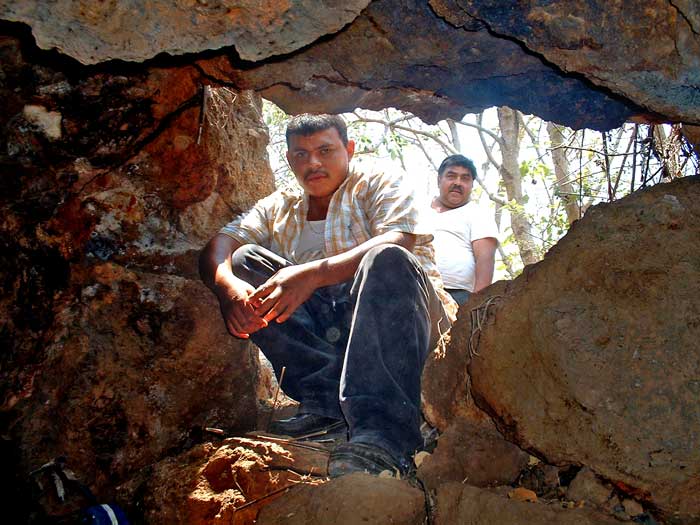 |
Much to Don José’s
surprise, we slid right into the cave like three lizards. Although none of us
had helmets and only a few little lights, we saw enough to figure this cave was
worth a return visit. And, of course, there was a nice current of air blowing
out of a low passageway…
The Australian
Connection
A month
or so passed. Then, determined to show visiting Australian caver Greg Middleton
a whopper of a lava tube, Sonia Calvillo, Chris Lloyd and John Pint took our
visitor back to the little town of Colonia Moderna, where we hoped to visit a
“really big” cave that Don José had told us about. A nice old guy named Don
Eduardo was supposed to take us there, but instead led us to a small cave which
was not very interesting, except for the fact that Greg was the only one bitten
by the cave’s ants, suggesting that Australian meat merits its reputation for
being extra tender.
 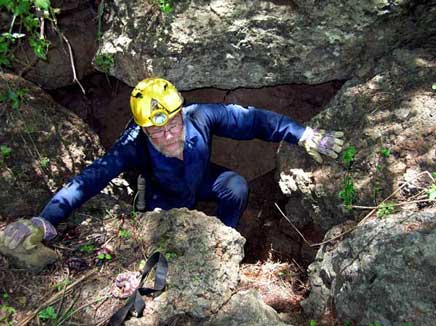
LEFT:Seventy-seven-year-old
Don Eduardo says, (after taking us to a little cave) "Oh, that BIG cave everybody talks about? Sorry, I've
never been there!"
RIGHT: Aussie Greg Middleton exiting Don
Eduardo's disappointingly small cave. |
|
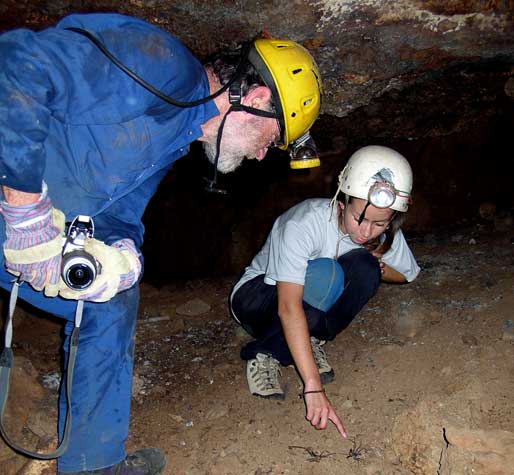
Greg and Sonia
investigate tindarapo molts in Cueva Eduardo
|
Giving
up the hunt for The Big One, we went back to La Cueva del Zurdo.
While
Chris and Greg did a geological examination inside, Sonia and I proposed to
start the survey. However, it turned out that somehow none of us had brought
along a clinometer, nor even a protractor and a string, each thinking the other
would have one. Fortunately, Chris had by then discovered more cave beyond the
entrance room, so we stowed the survey gear and began exploring.
The Obsidian Room
|
The
first room is about ten by twenty meters with a going passage at the far end.
The walls and roof of the passage are composed of pumice tuff and therefore
exceedingly soft. A belly crawl leads through a small room into the
Obsidian Room. The floor of this room is covered with breakdown but the
ceiling consists of
small, tightly packed obsidian fragments. Both Chris and Greg stated that
obsidian in a lava cave is rare indeed and probably unique.
Curious ceiling of the Obsidian Room.
|
 |
|
Detail of Zurdo Cave map,
showing Belly Crawl and Obsidian Room.
The small room between these two points is where we left the cameras after
discovering that the inner part of the cave was too humid for normal
photography. Click on this picture to see the complete map.
|
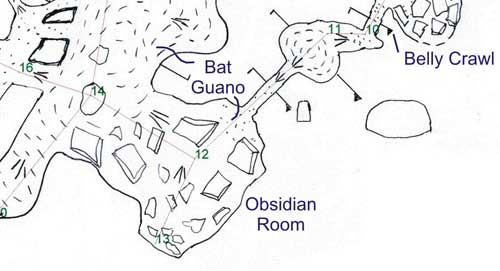 |
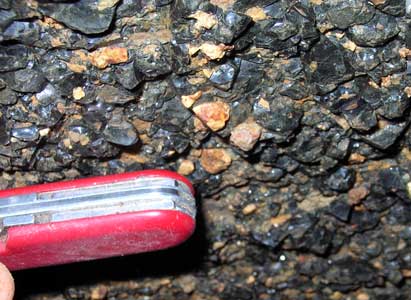  LEFT:
closeup of the tightly packed obsidian fragments making up the ceiling
of the Obsidian Room LEFT:
closeup of the tightly packed obsidian fragments making up the ceiling
of the Obsidian Room
RIGHT: One of several snake skins
we found in various parts of the cave. |
In this
area we found two puddles of semi-liquid vampire goo and a great deal of fresh
guano deposited by insectivorous bats. We also spotted a little spider and what
looked like a cockroach with an ovaloid form.
 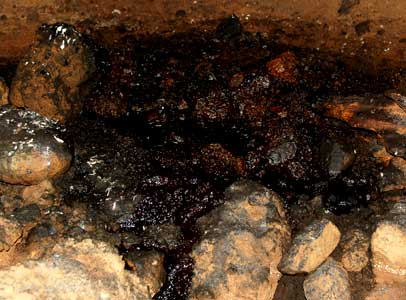
LEFT:A tailless whip
spider (Acanthophrynus coronatus) looks ferocious but is harmless to
humans. Cuevas Eduardo and Zurdo are full of them.
RIGHT: Both caves also feature a few pools
of smelly vampire guano, a black semi-liquid. |
Along the wall were entrances to
several other passages, each shaped like an A and so symmetrical that I wondered
whether they might not be man-made, considering how soft the walls are...
|
...Chris
disappeared into the biggest of these passages, resulting in a mass exodus of
bats. It appears there are at least three species in this cave and we hope we
can find a bat expert interested in visiting this place. Rather than cause any
more disturbance to the bats, we decided to postpone further exploration (and
our survey) until we could do this at night when the bats are all outside.
Chris Lloyd with bats
|
 |
Evil Weeds
Near
the end of November, 2006, we finally got enough cavers together to carry out
the survey of the cave. The crew consisted of Luis and Mary Rojas, Sonia
Calvillo, Chris Lloyd and John Pint. Our plan was to camp outside the cave so we
could survey at night when the large bat population would be outside, devouring
the local bugs.
We
pulled into Colonia Moderna in the late afternoon and told Don José our plan.
“Where are you going to camp?” he asked, “It’s all full of weeds.”
| ...Well,
of course, we weren’t afraid of a few weeds, so off we went. Chris parked nice
and close to the cave and we jumped out of the car… and that’s when we
discovered what Don José was talking about. In one minute, our pants were
covered with hundreds of the prickliest burrs the world has ever produced. We
had no problem learning the local name for these diabolical stickers
(huizapoles) as they seemed to repopulate our clothes and shoes as fast as we
could pull them off, and even weeks later—back home—we continued to find them in
the most unexpected places...
|
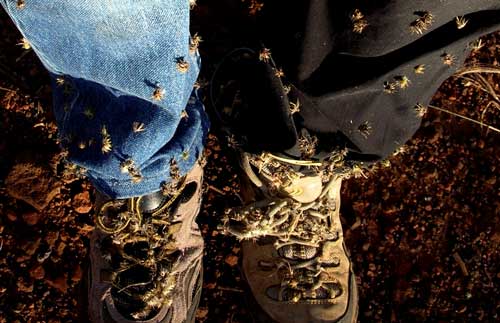 |
Shimmering white
walls
|
By the
time we got our tents up and had plucked all the “wee-sa-POL-es” (that’s the
pronunciation) off one another, it was dark. Chris had kindly chopped a path to
the cave and we crawled inside to begin the survey. One of the passages off to
the side of the first room was almost completely covered with a white sheen
caused by tiny water droplets stuck to what I assume is one of those bacterial
mats that Diana Northup is all excited about.
Sonia among the sparkles.
|
 |
|
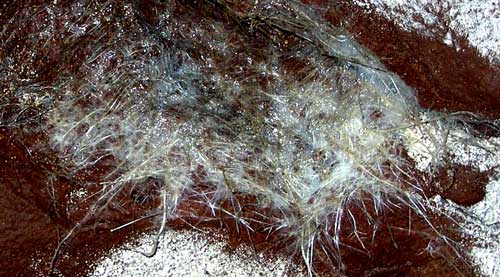
Curious "hairs"
(fungus?) were spotted near the bacterial mats
|
|
At the
far end of this room, there’s a small opening that one could easily miss.
Sliding through on your belly leads you to a room with a smooth, flat floor
where I decided to leave the thermometer and hygrometer. A smooth upslope at the
other end of this room leads deeper into the cave. This passage is typical of
many others in the cave: it’s A-shaped and flat on the bottom. I still wondered
if human beings had not assisted in enlarging the openings of this cave, but
Chris says all the passages were formed by natural, phreatic processes...
John Pint enjoying one of the belly crawls in
Zurdo Cave: "My poor camera!"
|
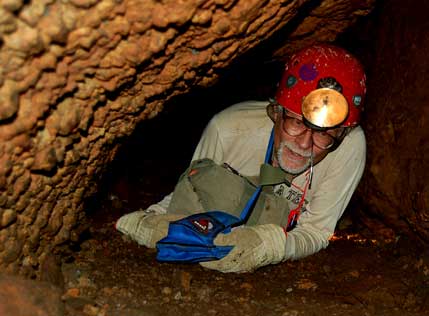 |
|
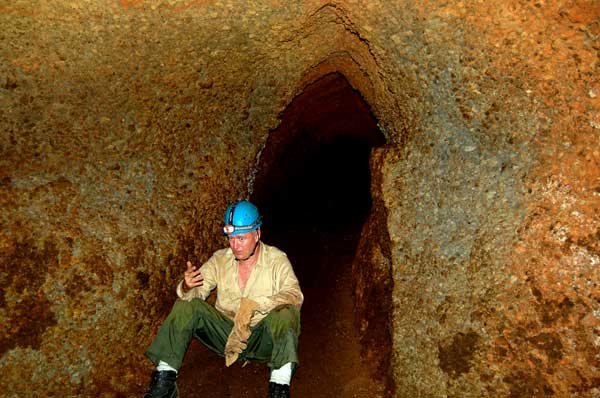
Chris Lloyd in front of a typical A-shaped
passage. Note the walls made of soft volcanic tuff or pumice.
|
The
next room was the famous Obsidian Room where we spotted several of the biggest
tindarapos we had ever seen (also known as tendarapos or canclos or cancles)
as well as some smaller ones with very noticeable white “elbows,” so I handed
the tip of the survey tape to Mary Rojas in order to take some pictures. I went
back to drag the tripods, flashes and other stuff into this room, got some good
shots of the ugly critters and then followed the surveyors into the next room.
This was the bat roost where we had stopped last time. Now it was mostly empty
except for a number of small bats with cute little faces hanging practically in
front of our eyes, their wings tightly folded. They were no longer than five
centimeters long and, of course, I wanted a picture. Sad to say, however, the
cave photography came to an end right in this room as every picture I took came
out foggy. Well, the truth is, I had measured 22 degrees and 98% humidity back
in the second room but the “bat zone” felt much hotter and stickier, so much so
that all of us were beginning to feel exhausted. However, there were a number of
interesting things we observed in this area, which is about 100 meters inside
the cave. First of all, there was a nest of leaf-cutter ants and next to their
hole was what to them must have been a veritable mountain of chewed-up leaves,
upon which these ants supposedly cultivate a tasty fungus. Normally, this “farm”
is located in a tunnel of the ants’ making, but in this case they could use a
hot, dark cave provided by Mother Nature. Naturally, this was another photo that
never was taken!
Prehistoric Pepsi
|
...We also
discovered a glass Pepsi bottle, the only human artifact we saw. It has what
seems to be an old, 1940’s logo on one side and a more recent logo on the other
and was made in Mexico… obvious proof that the ancient Aztecs preferred Pepsi
over Coke! A bit farther on, we found an interesting room with only one thing in
it: a rectangular, flat-topped rock about 60 cms long by 20 wide and 20 high.
The floor was perfectly flat and smooth and the rock—which was in the center of
the room—had obviously been transported here from elsewhere. Could this spot
have been used for ceremonies or meetings? OK, archeologists, when does the
investigation start?...
"Too bad it's empty" says John, admiring the
ancient Pepsi bottle.
|
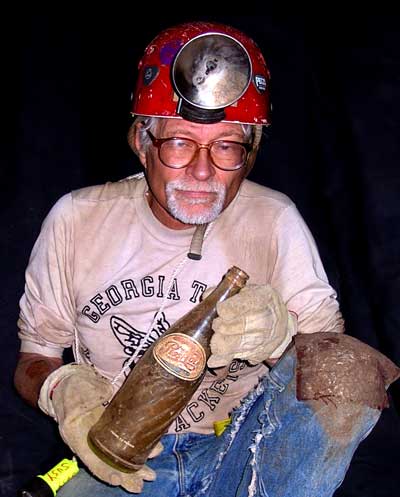 |
 
SURVEYORS HARD
AT WORK
LEFT: Luis Rojas (under the Sherlock Holmes
Caving Helmet) trying to get a reading as sweat pours into his eyes.
RIGHT: Chris Lloyd sketching. Note the
obsidian stratum above his head. |
In this
part of the cave, there were passages going every which way, most of them
beginning as a more-or-less triangular shaped opening. At the end of two of them
we found ceiling exits, no doubt used by the bats.
After
mapping some 240 meters of passages, we headed out. Along the way, in the
obsidian room, Luis and I spotted the strangest cave creature we’d ever seen. It
has the oversized legs of a walking stick, but a shorter and thicker body. It
didn’t react to a flashlight circling it, so we imagined it was blind. Once
again, we got no pictures, having left the cameras in less steamy parts of the
cave...
| ...We
exited, dripping with sweat, quickly finished off all the beer and soon
crawled into our tents... This is
one hot and sticky cave! Notice the only one smiling is Mary Rojas...what's
your secret, Mary? |
 |
|
... Although we seemed to be in the middle of nowhere, with the
great hulk of Sanganguey Volcano looming above us in the night sky, we could
still hear—all too clearly—the blast of trumpets from a Mariachi band somewhere
on the other side of the cane field. It was a typical Mexican Saturday-Night
Fiesta, but I was so worn out from that steamy cave that I didn’t even notice at
what time the Ranchero music was replaced by the natural sounds of crickets and
owls.
Camping under the shadow of
Sanganguey Volcano. |
 |
| The
next morning we packed up and spent a bit of time with Don José, who proudly
showed us his tobacco crop. Thousands of tobacco leaves were neatly hung side by
side beneath a tin roof. As none of us knew much about this crop, Don José
demonstrated how to tell a good tobacco leaf from a bad one. “Just crumple it up
in your hand. When you let go, a good leaf will quickly resume its original
shape, whereas a low-quality one will stay crumpled.” The only smoker in our
group was Luis Rojas, but I’m sure he’ll bear this info in mind next time he
camps in a tobacco field.
Chris checks the quality
of Don Josés weed.
|
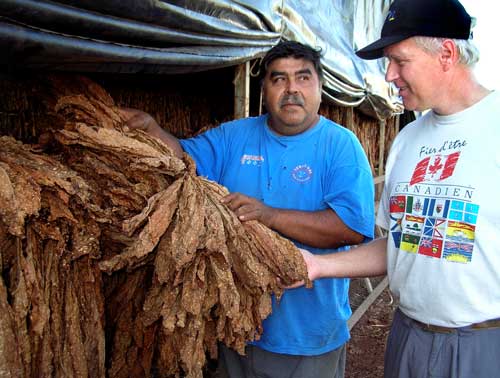 |
As we
had plenty of time on our hand, having completed the cave survey, we decided to
check out a local town named “Las Cuevas” (which we had spotted on the map) to
see if there were actually caves there. So we drove to San José Mojarras and
started hunting for a dirt road hopefully heading towards Las Cuevas. Well, we
found a road alright, but it forked quite a few times and all we could do each
time was to randomly pick a direction. This technique worked perfectly, no doubt
because the car was full of typical cavers with the extraordinary ability to
sniff out “cuevas” at a distance. Thirteen kms from San José Mojarras, we
arrived at our goal.
The
Wonderful Rivers of Las Cuevas
Las
Cuevas turned out to be a typical pueblito in all respects but one: a
surprisingly large number of people had a boat in their back yard. When we
stopped to chat with a local youth, he explained that we were very close to the
banks of the Santiago River, which, the young man told us, “is broad and clean”
in this area, and very nice for boating. This seemed hard to believe as this
river is a stinking soup of toxic waste after it flows around the city of
Guadalajara, about 250 kms upstream. “No, no,” said our informant, “the river is
clean here—many people in our village are fishermen, including me. We get very
nice tilapia from the Santiago River.” Of course, we also asked about the
cuevas for which this village is named. “Ah, these caves are on the
property of Don Antonio Cabanilla.”
|
Well,
soon we were chatting with Don Antonio’s wife, who assured us her husband was
very much interested in caves and such and a little while later Don Antonio
himself took us on a tour of a river and waterfall on his property. We were
amazed at how beautiful this place was but Don Antonio remarked that there’s
another waterfall further down the hill which is much bigger and more
impressive. “Come and camp here on my property. I’ll show you several nice
places to swim and I’ll take you to several caves around here.”...
Don Antonio's river has
several good places for swimming, as long as you don't accidentally go over
the waterfall.
|
 |
On our
way back, we ran into a fellow named Don Simón who also promised to take us to
several mysterious pits he knew about. Don Simón turned out to be quite a
comedian and after he drank one beer, had us all in stitches.
 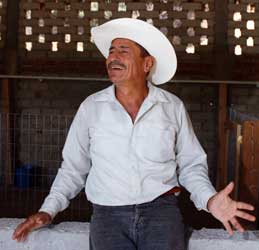
Left: Don
Simón
Right: Don Antonio
Is Las Cuevas the new Shangri-la? |
Swimming holes, waterfalls, boating, fishing and caves! Las Cuevas turned out to
be quite a find. Don’t worry, Don Antonio…we’ll be back!








 LEFT:
closeup of the tightly packed obsidian fragments making up the ceiling
of the Obsidian Room
LEFT:
closeup of the tightly packed obsidian fragments making up the ceiling
of the Obsidian Room
















